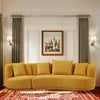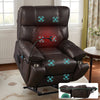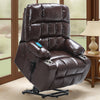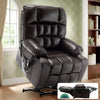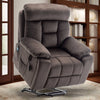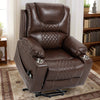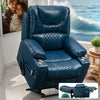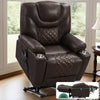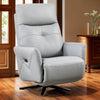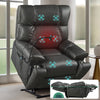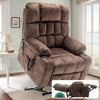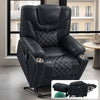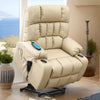Understanding the Needs of Elderly Individuals
Assessing Mobility and Comfort Requirements
As we age, our mobility and comfort needs change. Seniors often face challenges with sitting and standing. They may experience joint pain, muscle weakness, or balance issues. These problems can make daily activities difficult.
Proper seating solutions are crucial for the elderly. They need chairs that offer support and ease of use. The right chair can help maintain independence and improve quality of life. It's important to consider factors like height, depth, and firmness of the seat.
Some seniors may require chairs with higher seats for easier standing. Others might need extra lumbar support for back pain. Armrests can provide stability when sitting or rising. The goal is to find a chair that meets individual needs and promotes comfort.
The Importance of Ergonomic Design in Products for the Elderly
Ergonomic design is vital for senior-friendly products. It focuses on creating items that fit the user's needs and abilities. For the elderly, this means chairs that reduce strain and increase comfort.
Ergonomic chairs can help prevent pain and injury. They support good posture and reduce pressure on joints. This is especially important for seniors who spend a lot of time sitting. The right design can improve circulation and reduce the risk of pressure sores.
Ergonomic features might include adjustable components and easy-to-use controls. These allow seniors to customize their seating position. Proper design can also make it easier for caregivers to assist seniors. The goal is to create a safe, comfortable, and user-friendly environment for the elderly.
Evaluating Lift Chairs and Recliners for Elderly Use
Key Features to Look for in Lift Chairs
Lift chairs are specialized recliners that help seniors stand up and sit down. When choosing a lift chair, several key features should be considered:
- Lifting mechanism: Look for smooth, stable operation.
- Weight capacity: Ensure it can support the user's weight.
- Number of positions: More positions offer greater flexibility.
- Fabric: Choose durable, easy-to-clean materials.
- Battery backup: Important in case of power outages.
- Remote control: Should be simple and easy to use.
- Size: Must fit the user and the room space.
- Seat height: Should allow feet to touch the ground when seated.
Other useful features might include heat and massage options. Some chairs offer built-in USB ports for charging devices. The best lift chair will depend on the individual's specific needs and preferences.
Comparing Recliner Designs for Maximum Comfort
Recliners come in various designs, each offering different benefits for seniors:
- Rocker recliners: Provide a gentle rocking motion.
- Wall-hugger recliners: Ideal for small spaces.
- Push-back recliners: Simple to operate but may be hard for some seniors.
- Power recliners: Offer easy adjustment with motorized controls.
- Zero-gravity recliners: Reduce pressure on the spine and joints.
When comparing recliners, consider the following:
- Ease of use: Controls should be simple and accessible.
- Comfort: Look for good lumbar support and cushioning.
- Durability: Choose sturdy construction and quality materials.
- Size: Ensure it fits the user's body type and room space.
- Footrest: Should provide adequate leg support.
The best recliner will depend on the senior's specific needs and physical condition. Some may prefer a simple design, while others might need more advanced features.
Implementing Lift Chairs and Recliners in Senior Living Facilities
Cost-Benefit Analysis of Lift Chairs vs. Recliners
When deciding between lift chairs and recliners for senior living facilities, cost is a key factor. Here's a breakdown of the costs and benefits:
Lift Chairs:
- Higher initial cost
- May reduce caregiver strain and injury
- Can help maintain resident independence
- Potential to decrease fall risks
Recliners:
- Generally less expensive
- Simpler design with fewer mechanical parts
- May require less maintenance
- Can still provide comfort and relaxation
Benefits of both:
- Improved comfort for residents
- Potential reduction in pressure sores
- Enhanced quality of life for seniors
While lift chairs are more expensive, they may offer long-term savings. They can reduce the need for staff assistance and lower injury risks. Recliners are more budget-friendly but may not meet all mobility needs.
Facilities should consider their residents' needs and budget constraints. A mix of both types might be the best solution for diverse senior populations.
Training and Safety Considerations for Lift Chairs and Recliners
Proper training and safety measures are crucial when using lift chairs and recliners in senior facilities. Here are some key points to consider:
Staff Training:
- Teach proper operation of lift chairs and recliners.
- Explain how to assist residents safely.
- Emphasize the importance of regular maintenance checks.
Resident Education:
- Demonstrate how to use controls and features.
- Explain safety precautions and potential risks.
- Encourage residents to ask for help when needed.
Safety Measures:
- Keep pathways clear around chairs.
- Regularly inspect chairs for wear and tear.
- Ensure power cords are safely positioned.
- Use non-slip mats near chairs if needed.
Emergency Procedures:
- Have a plan for power outages (especially for lift chairs).
- Train staff on what to do if a resident is stuck in a chair.
- Keep emergency contact information easily accessible.
By implementing thorough training and safety protocols, facilities can maximize the benefits of lift chairs and recliners. This helps ensure a safe and comfortable environment for seniors.
Regular reassessment of residents' needs is also important. As conditions change, seating solutions may need to be adjusted. The goal is to maintain safety, comfort, and independence for all residents.







